If a single word could be used to describe the 2400-acre Shaw Nature Reserve 40 miles southwest of downtown St. Louis in Franklin County, it would be silence. When a soul craves contemplation or calm, it’s the silence that attracts. It’s not serenity I’m looking for, though, but rather a cure for restlessness.
I’ve been here before, and late November is a good time to visit. The temperatures are cool without being chilling; slithering creatures have crawled into their dens for the approaching winter; and the gray brownness of the trees and terrain guarantees few visitors, especially on a Monday.
The reserve opens around Pinetum Lake, and the scene, especially in autumn, could pass for a landscaped design in 18th century England, like at Blenheim Palace. All that’s missing is the Greek temple.
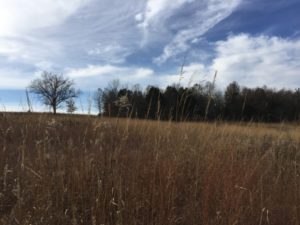
The herd of “anny-muls” emerged from the trees right here.
I’ve been coming here for years. When my boys were children, the three of us often hiked here. When my youngest was 4 and the oldest 12, we did a November hike like I’m doing today. The 4-year-old was the first to spot something I hadn’t seen before — a herd of about 50 deer suddenly emerging from the distant woods. “Look!” he said. “Anny-muls!” That was 27 years ago, and I still smile at the “anny-mul “spot.
The sons are off on their own careers now, so instead of sons I bring three poets with me. One lives in southern Illinois, one in the Missouri Ozarks, and one in Oklahoma. None of them is what you’d call a “nature poet,” but they know this kind of terrain I’m walking — part of the American plains but hilly, wooded, and shaped by wind and rivers., the foothills of the Ozarks. The landscape is deceptive, though; it was originally part of the Great American Prairie, an ocean of grasses and tall plants stretching for hundreds of miles. Before the pioneers came, more than a third of Missouri was covered by prairie.
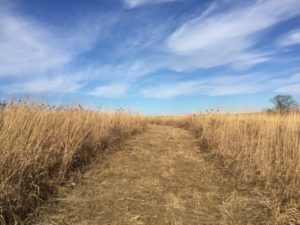
A mown path leads through part of the prairie restoration area at the Shaw Nature Reserve.
What’s left exists in isolated pockets, but the pockets are nurtured and growing, cared by groups like the Missouri Prairie Foundation. Here at the nature reserve, a large prairie restoration project has been underway for years, and you can get a sense of what native Americans and new Americans experienced when it was much larger.
After my Sally died I came out here
for peace but found the high plains like a river
in flood, the sod busters busting their sod
in breaking waves over the grassy plains.
Dang fool, I thought I could shake the Lord.
— from “The Reverend Describes the Sod Busters” in Black Sunday by Benjamin Myers
You can walk through the reserve’s prairie space and actually see what some of that sod looked like before it was busted. In many places, the roots of the prairie grasses and plants extended several feet into the ground. The soil was rich, but it took some busting to get to it. And that busting would eventually lead to the Dust Bowl of the 1930s, which Myers chronicles so well in his collection.
After the prairie area, I continue on the trail, past the trail house (and its picnic tables, water fountain, and bathrooms). I’ve seen a couple walking in the distance, but I’ve been walking for more than 25 minutes and they’re the only people I’ve noted. The interstate highway noise has been left far behind, and now I’m surrounded by a silence so deafening that the only sound is leaves crunching beneath my feet. If I stand still, which I do often, I can hear absolutely nothing. It’s easy to believe you’re the only person in the world.
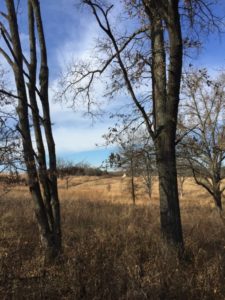
Trees frame a wider view of the prairie.
Rocky moon rips
through icy November sky.
Alone on the farm, I walk
the north ten in my ropers and pull plaid
to cover the blade-ready throat.
Separation feels so absolute
it takes on the ugliness of divorce:
house axed in half, a child’s bee bonnet
sliced like bread, the unkempt lawn
filled with cavities where love lost.
This feeling is mostly myth. Or is it?
— from the title poem in View from the North Ten by Dave Malone
I veer off the central Brush Creek Trail onto what’s called the Wildflower Trail, which at this time of the year is minus the wildflowers. The direction is mostly down toward the creek bottoms, which will never be quite reached without a second detour. Instead, the trail will regularly shift upward and downward, in a zigzagging repetition.
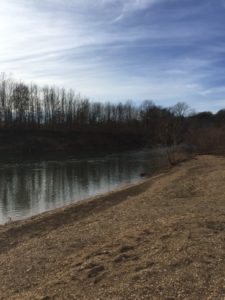
Gravel bar, Meramec River, Shaw Nature Reserve.
Eventually it takes a hard turn downward, the sign that I’m nearing the Meramec River, the smallest of the three rivers that triangulate the St. Louis region (along with the Missouri and the Mississippi). The Meramec meanders all over the terrain. It will eventually pass six blocks from my oldest son’s home in Jefferson County and skirt my own suburb of Kirkwood in St. Louis County, before it joins the Mississippi.
The major attraction here is the extensive gravel bar along the north side of the Meramec. You can walk the bar for a good two to three blocks watching the river, looking at the bluffs on the other side, and looking behind you at the even taller bluffs on your side. This area regularly floods, the river expanding in a dangerous rush before receding into its normal calmness. Today, even the river is silent. I’ve been here and heard the sounds of water pouring over rocks and trees, but today it flows without a sound.
This is the birthing-place:
One small shoot of buffalo grass holds the sun speared and
roundly trembling
on its
flexed
point.
I lay,
stretched out among the institutions of grass-hoppers
assembled in the dusty
cover of the rasping grass,
obscured by blandness,
betrayed by their bug-eyes.
— from “Three Meditations Between Earth and Sky” in Elegy for Trains by Benjamin Myers
I could sit for hours on one of the many weathered tree trunks scattered about, listening to the silence. I read Norman Maclean’s A River Runs Through It more than 30 years ago, and right at this moment, by this small sunlit river, I think that the title of that book might be wrong. It should be “A Poem Runs Through It.”
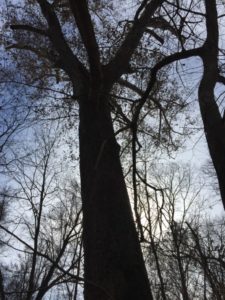
The tree that endures
I find my way back, stopping by “the tree.” It’s about a hundred yards from the river and is likely one of the oldest trees in the entire reserve. It takes four of me fingertip to fingertip, plus about two feet, to hold the circumference. It’s been through storm and flood and insects and likely someone eyeing it for building materials or firewood. But it endures.
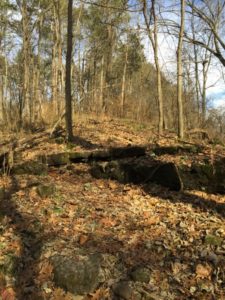
Yes, that’s the trail to the overlook.
Then I make my way to the trail that leads up to what’s simply called “the overlook,” the top of a cliff where you can see for miles. The trail upward will at times disappear among the rocks and stones, and you have to guess where to go while you’re walking at what seems like a 45-degree angle. My calves remind me it’s been a while since my last visit.
At the top, it’s more silence. I’ve sometimes heard the sound of cowbells from the bluffs across the river, but the cows must be somewhere else today. When I peer over the cliff, I realize what I’m doing — experiencing a scene from a work in progress to sense what the danger feels like. In fact, the work in progress is likely what’s brought me to the reserve today, to clear my head, distract me from the hard work of writing, and get me to listen to what the silence has to say.

The hole where the black furry thing went
I’m back on the trail, less than three blocks from where I’m parked, when a black furry ball of something suddenly darts in front of and runs down the trail. It looks like a miniature bear cub, but that’s unlikely. I follow it, watching, it until it suddenly dives into a hole in the underbrush.
Counting the man at the ranger station who tells me I saw a groundhog (“Whole families of them live out here,” he says), I’ve seen six people during my hike. I’ve talked with three more, the three who wrote the poems that I have with me. I’ve read their poems aloud for only my own ears, and heart.
I’ve never done this hike with poets before, and they’ve added something that’s as deep as the silence. They ask you to consider where you’ve come from, because it might explain where you’re going. In that sense, they’re the trail guides at the nature reserve.
… he can finally set free some words
He has shouldered these ten-thousand days.
They are good words, but insufficient.
He is grateful, at least, to deliver them
before the mortician picks his pockets
and paints away the craters around
his own window-broken eyes.
— from “The Pilgrim” in The Inheritance: Poems and Photographs by Justin Hamm
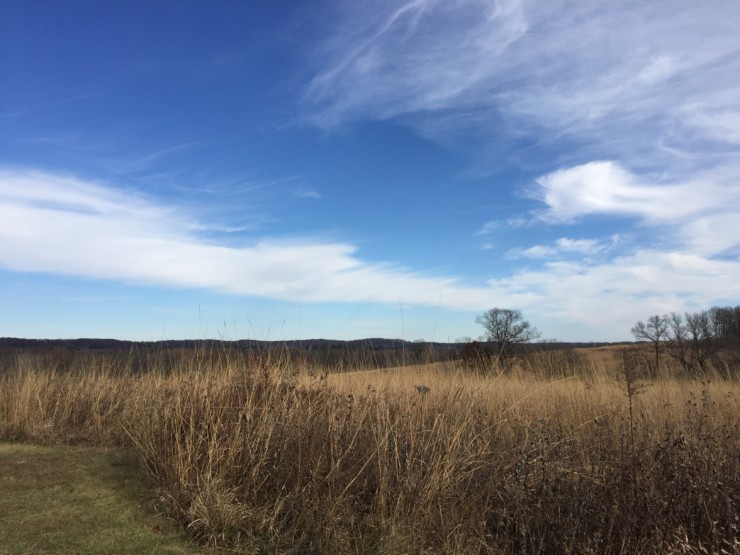
The place where silence reigns
Related: Wallace Stevens and Walking the Landscape
Photos and post by Glynn Young.
__________________________

“I require all our incoming poetry students—in the MFA I direct—to buy and read this book.”
—Jeanetta Calhoun Mish
- Poets and Poems: Sandra Marchetti and “Diorama” - April 24, 2025
- Poets and Poems: Christina Cook and “Roaming the Labyrinth” - April 22, 2025
- Longfellow’s “Paul Revere’s Ride”: Creating a National Legend - April 17, 2025
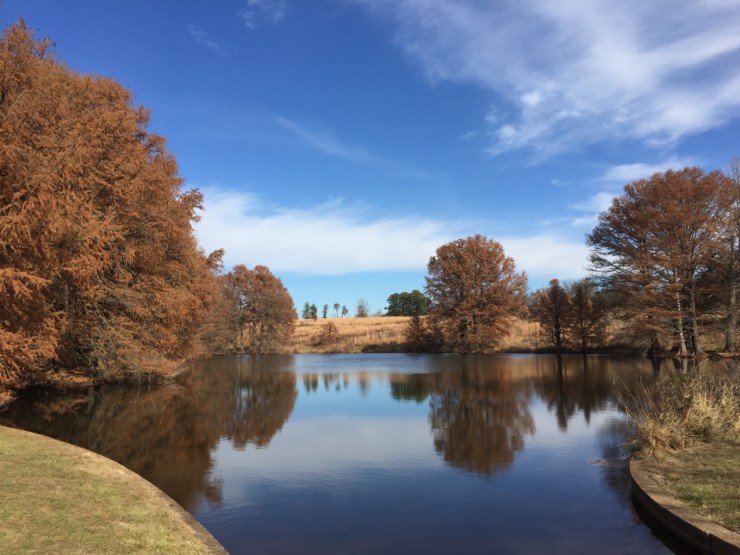
Maureen says
Lovely essay, Glynn.
Glynn says
Maureen, thank you!
L.L. Barkat says
I love the idea of pairing poetry and nature. It seems to me that nature is what poetry first springs from—the richness of sound (and silence), the golden movements (Wordsworth’s daffodils!), the fragrances that tickle and spin.
Thanks for sharing your paired experience with us. 🙂
Dave Malone says
Dear Glynn,
Thank you for sharing this journey. With the complementary pictures, it does feel as if we too get to take part in this walk. I love the silence. I love the grand tree. I love the distinct prairie and sky. And of course, the Anny-muls. I like that you stop often, for how often are we not stopping? … just going…And where is it that we are going? And there are so few places in our world (whether in SL or KC or NY or WP (West Plains, MO)) where we can hear absolutely nothing. These places do exist, and we might do well to go to them as often as we can. 🙂
Glynn says
I love the silence, Dave. If I really listen, I’m amazed at how loud it can be.
Megan Willome says
Glynn, this is one of the most beautiful things you’ve ever written (and that’s saying something). You make me want to walk through this preserve with these poets too.
Maybe I’ll take mine to my places instead.
Love your captions too.
Glynn says
Megan, thank you.
Richard Maxson says
Glynn, I feel like I’ve just been there. I wish it were true. Beautiful writing and photos about what must be a place with landscapes to make visitors hold their breaths. And yes, the volume of silence is deafening.